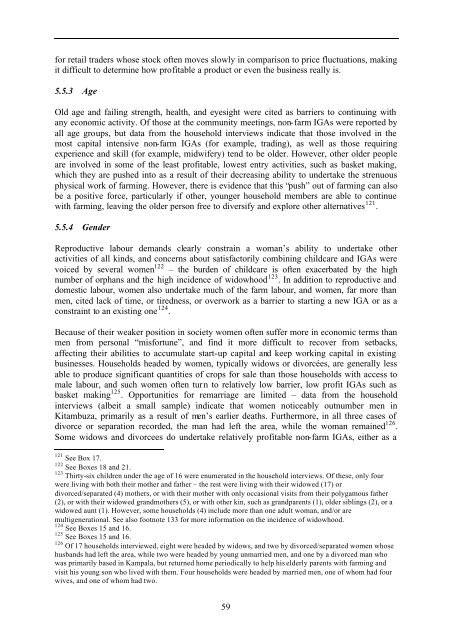Access to Rural Non-Farm Livelihoods - Natural Resources Institute
Access to Rural Non-Farm Livelihoods - Natural Resources Institute
Access to Rural Non-Farm Livelihoods - Natural Resources Institute
You also want an ePaper? Increase the reach of your titles
YUMPU automatically turns print PDFs into web optimized ePapers that Google loves.
for retail traders whose s<strong>to</strong>ck often moves slowly in comparison <strong>to</strong> price fluctuations, making<br />
it difficult <strong>to</strong> determine how profitable a product or even the business really is.<br />
5.5.3 Age<br />
Old age and failing strength, health, and eyesight were cited as barriers <strong>to</strong> continuing with<br />
any economic activity. Of those at the community meetings, non-farm IGAs were reported by<br />
all age groups, but data from the household interviews indicate that those involved in the<br />
most capital intensive non-farm IGAs (for example, trading), as well as those requiring<br />
experience and skill (for example, midwifery) tend <strong>to</strong> be older. However, other older people<br />
are involved in some of the least profitable, lowest entry activities, such as basket making,<br />
which they are pushed in<strong>to</strong> as a result of their decreasing ability <strong>to</strong> undertake the strenuous<br />
physical work of farming. However, there is evidence that this “push” out of farming can also<br />
be a positive force, particularly if other, younger household members are able <strong>to</strong> continue<br />
with farming, leaving the older person free <strong>to</strong> diversify and explore other alternatives 121 .<br />
5.5.4 Gender<br />
Reproductive labour demands clearly constrain a woman’s ability <strong>to</strong> undertake other<br />
activities of all kinds, and concerns about satisfac<strong>to</strong>rily combining childcare and IGAs were<br />
voiced by several women 122 – the burden of childcare is often exacerbated by the high<br />
number of orphans and the high incidence of widowhood 123 . In addition <strong>to</strong> reproductive and<br />
domestic labour, women also undertake much of the farm labour, and women, far more than<br />
men, cited lack of time, or tiredness, or overwork as a barrier <strong>to</strong> starting a new IGA or as a<br />
constraint <strong>to</strong> an existing one 124 .<br />
Because of their weaker position in society women often suffer more in economic terms than<br />
men from personal “misfortune”, and find it more difficult <strong>to</strong> recover from setbacks,<br />
affecting their abilities <strong>to</strong> accumulate start-up capital and keep working capital in existing<br />
businesses. Households headed by women, typically widows or divorcées, are generally less<br />
able <strong>to</strong> produce significant quantities of crops for sale than those households with access <strong>to</strong><br />
male labour, and such women often turn <strong>to</strong> relatively low barrier, low profit IGAs such as<br />
basket making 125 . Opportunities for remarriage are limited – data from the household<br />
interviews (albeit a small sample) indicate that women noticeably outnumber men in<br />
Kitambuza, primarily as a result of men’s earlier deaths. Furthermore, in all three cases of<br />
divorce or separation recorded, the man had left the area, while the woman remained 126 .<br />
Some widows and divorcees do undertake relatively profitable non-farm IGAs, either as a<br />
121 See Box 17.<br />
122 See Boxes 18 and 21.<br />
123 Thirty-six children under the age of 16 were enumerated in the household interviews. Of these, only four<br />
were living with both their mother and father – the rest were living with their widowed (17) or<br />
divorced/separated (4) mothers, or with their mother with only occasional visits from their polygamous father<br />
(2), or with their widowed grandmothers (5), or with other kin, such as grandparents (1), older siblings (2), or a<br />
widowed aunt (1). However, some households (4) include more than one adult woman, and/or are<br />
multigenerational. See also footnote 133 for more information on the incidence of widowhood.<br />
124 See Boxes 15 and 16.<br />
125 See Boxes 15 and 16.<br />
126 Of 17 households interviewed, eight were headed by widows, and two by divorced/separated women whose<br />
husbands had left the area, while two were headed by young unmarried men, and one by a divorced man who<br />
was primarily based in Kampala, but returned home periodically <strong>to</strong> help his elderly parents with farming and<br />
visit his young son who lived with them. Four households were headed by married men, one of whom had four<br />
wives, and one of whom had two.<br />
59

















